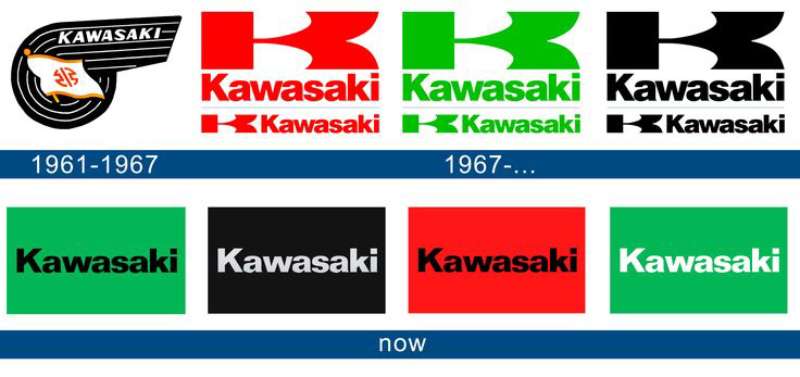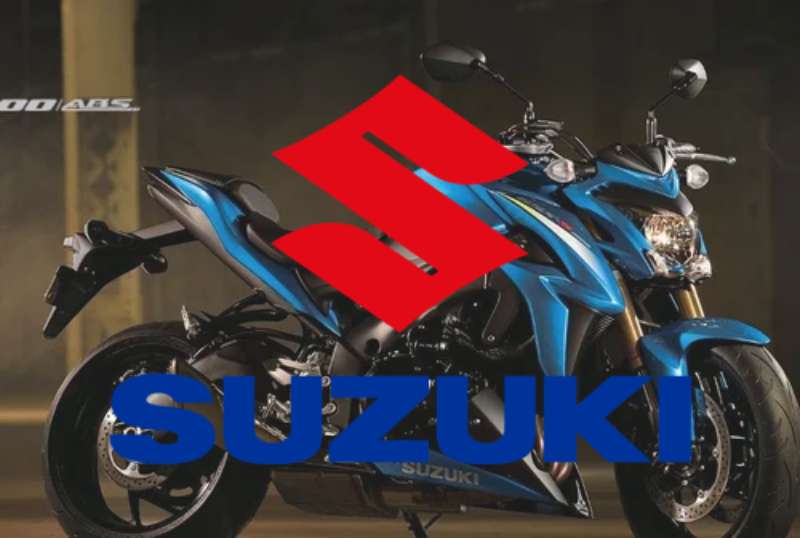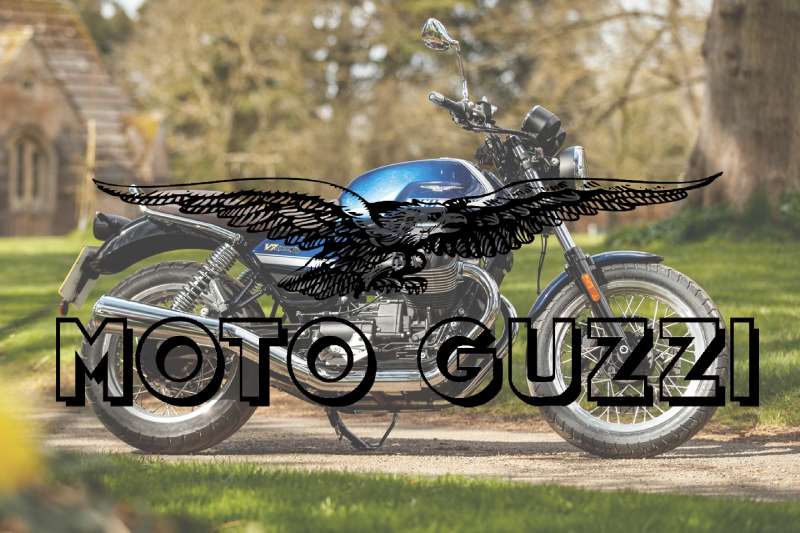The Kawasaki Logo History, Colors, Font, and Meaning
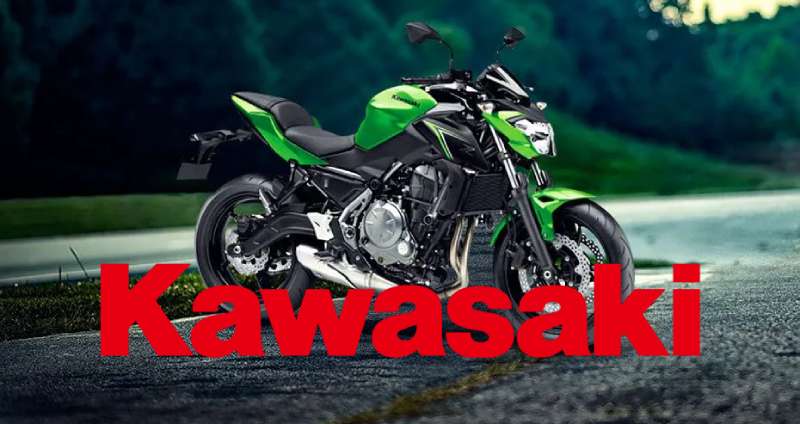
Imagine tracing the lineage of an icon—a symbol that whisks through streets and across imaginations, where green flashes and the growl of an engine conjure tales of adrenaline and innovation. The Kawasaki logo, a beacon of two-wheeled excellence, invites you into its world.
Within these lines, the mystique of a motorcycle legend unfolds, opening a path to discovery. Here, emblem and ethos fuse, exploring the visceral bond between rider and ride.
Delve deep into the tapestry of Kawasaki’s history and the very essence of its brand identity—from the emblematic green and black to the Ninja’s bold badge, each insignia narrates a chapter of the tale.
You’ll emerge with new insights—from the genealogy of an emblem that has evolved across decades to the intricacies shaping visual identity in the indomitable powersports branding scene.
Unpack the method and the muse behind the graphic design that propels a mere logo into a cultural artifact, capturing the spirit of movement in its wake.
The Meaning Behind the Kawasaki Logo

Oh man, you ever look at a logo and wonder, What the heck is the story behind that? Well, let’s break down the Kawasaki logo.
The Energy Vibe
You know that distinct emblem? The lines moving outward in all directions? Feels a bit like dynamism and energy, doesn’t it?
It’s like the universe bursting out in every direction. They wanted to convey power, innovation, and the forward thrust of technology.
It’s Not Just Bikes
Sure, most of us think of motorcycles when we hear “Kawasaki,” but this Japanese giant’s got its fingers in a lot of pies, from ships to aerospace to infrastructure. The expansive design of their logo kinda nudges at that. It’s as if it’s saying, “Hey, we’re not just about bikes, okay?”
The History of the Kawasaki Logo
Humble Beginnings
Started off in 1896 – yup, way back – not as a motorbike company, but in the shipbuilding arena. And the logo? It has evolved.
The Shifts and Twists
Through the decades, Kawasaki tried a few tweaks here and there. From simple scripts to emblems, they had a journey finding their identity. But one thing was consistent: a sense of movement. It’s like the brand’s always been on wheels, even before they made those cool bikes.
The Colors of the Kawasaki Logo

Colors, man, they’re not just for looking pretty.
Green Machine
Ever noticed that bold green? That’s not just any green; that’s Kawasaki green. It stands out, doesn’t it?
It’s like the grass but on energy drinks. Green often symbolizes growth, harmony, and freshness. And trust me, that green does scream, “Look at me, I’m vibrant and alive!”
Fiery Accent
Then there’s the hit of red. This isn’t the red that whispers; it’s the red that roars. The kind of red that’s all about energy, action, and determination. In the Kawasaki logo, red brings an aggressive edge, an adrenaline rush that promises power and performance.
It’s a dynamic accent that says Kawasaki machines are not just lively; they have a soul fired up and ready to lead the pack.
Why Not Just Black and White?
While the primary color of the Kawasaki logo we often see is green, there have been versions in monochrome. Black and white often gives a timeless, classic feel. But the green? It’s like the soul of Kawasaki.
The Font Used in the Kawasaki Logo
Bold and Forward
The font? Oh, it’s as bold as their bikes. Clean lines. No fuss. A typeface that means business. It’s futuristic but not too sci-fi. A balanced blend of tradition and the path forward.
The Aesthetics of the Logo
Minimal Yet Powerful
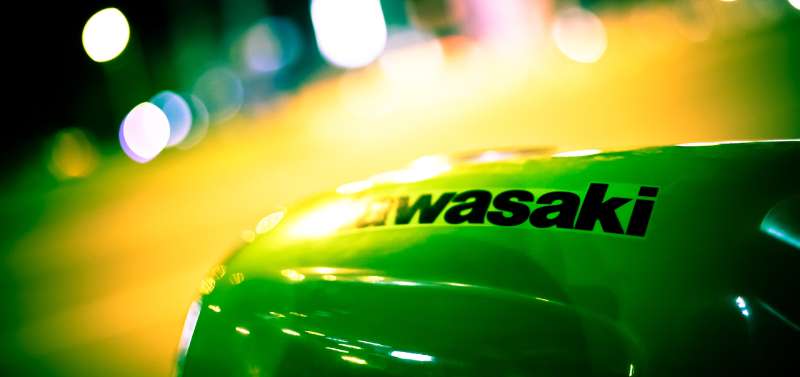
In a world of clutter, Kawasaki keeps it clean. No intricate drawings. No overly detailed patterns. Just pure, straightforward design. It’s like they’re saying, “We let our products do the talking.”
Adaptability
Whether on a bike, a brochure, or a massive ship, this logo just fits. It’s got this chameleon-like ability to belong anywhere and everywhere.
Perception in Popular Culture
More than Just a Logo
For many, especially bike enthusiasts, this logo is like a badge of honor. You sport it, you’re part of a tribe.
Movies and Media
How many times have you spotted that familiar green in movies, races, and shows? It’s like wherever there’s action, Kawasaki’s right there, in the thick of things.
FAQ On The Kawasaki Logo
What is the meaning behind the Kawasaki logo?
The Kawasaki logo encapsulates the brand’s dynamic essence. A force to be reckoned with, the stylized ‘K’ signifies speed and performance, while the distinctive green reflects energy and growth. It embodies the spirit of movement ingrained in Kawasaki’s visual branding.
How has the Kawasaki logo evolved over time?
Witnessing gradual refinement, the logo’s evolution mirrors Kawasaki’s heritage. Once a simple flag paired with the company name, it transformed into the bold emblem we recognize today—clean, incisive, and retaining the iconic Kawasaki green that crowns it as an industrial design mainstay.
Why does Kawasaki use green in its logo?
Green in the Kawasaki logo is iconic, branding the company with a unique vibrance. This choice diverges from the prevalent reds and blues in the motoring world, positioning Kawasaki as innovative, fresh, and synonymous with iconic motorcycle logos that resonate with riders globally.
Is the Kawasaki logo trademarked?
Assuredly, Kawasaki’s logo is trademarked, a standard in exercising legal diligence. This safeguards Kawasaki’s corporate identity and protects the visual identity from infringement, reflecting the importance of intellectual property in the vehicle industry.
What do the different elements of the Kawasaki logo represent?
Manifested as strength and excellence, every curve and color of the Kawasaki logo conveys meaning. The strong ‘K’ speaks of Kawasaki’s leadership and prowess in engineering, while the swift lines suggest speed—an attribute revered in the powersports branding domain.
Who designed the Kawasaki logo?
The unsung hero behind the Kawasaki logo’s current incarnation remains shrouded in corporate mystery.
What’s clear is that this emblem’s design echoes the collective vision of Kawasaki’s brand—innovation, quality, and the spirit of adventure embraced in its marketing campaigns.
Can the Kawasaki logo be used for personal purposes?
Utilizing this trademarked logo for personal use borders on legal infringement. Use caution; permission is typically required to use Kawasaki’s intellectual property, reflecting the significance company insignia history has in brand image and marketing.
Are there any restrictions on using the Kawasaki logo for business?
For business use, restrictions apply. Trademark design and laws protect Kawasaki’s logo; hence, companies should seek consent to avoid infringing on corporate branding rights—a point underscoring the gravitas of trademark design.
Does Kawasaki have different logos for different products?
Kawasaki’s branding remains consistent across product lines; however, adaptations—like the Ninja’s distinctive badge—flourish, offering variations that speak to the particularities of each offering, from motorcycles to Jet Skis.
How often does Kawasaki update or change its logo?
Change isn’t impulsive for a brand legacy like Kawasaki. Logo updates are sparse and deliberate, ensuring every transition in logo redesign is meaningful and aligns seamlessly with the ongoing brand identity narrative.
Conclusion
Circling back to where we began, it’s clear that the Kawasaki logo does much more than identify a manufacturer. It’s a visual symphony, a beacon to the brand’s adherence to innovation and its green streak cutting through the cliché red and blues. Standing out, it invites enthusiasts and onlookers alike into a world where speed meets prestige.
The emblem has ridden a long trail, evolving yet steadfast in its core values—confidence, power, and performance. Its versatility across Jet Skis, ATVs, and motorcycles speaks to a design aesthetic as adaptable as it is iconic. Through every iteration, Kawasaki has ensured its visual identity remains symmetrical with its legacy—a torchbearer of quality in the automotive sector.
As the curtain falls on this exploration, what remains etched is a deeper comprehension of how a solitary logo can carve a niche, spell a narrative, and galvanize a legion of followers. The Kawasaki logo isn’t just a mark; it’s a heritage cast in green and black.
If you liked this article about the Kawasaki logo, you should check out this article about the Suzuki logo.
There are also similar articles discussing the Yamaha logo, the Indian Motorcycle logo, the KTM logo, and the Husqvarna logo.
And let’s not forget about articles on the Ducati logo, the Triumph logo, the KYMCO logo, and the Aprilia logo.
- Think Pink: Soft and Strong Pink Color Palettes - 14 May 2024
- Fashion Typography: What Font Does Vogue Use? - 14 May 2024
- The Kirin Logo History, Colors, Font, And Meaning - 13 May 2024






